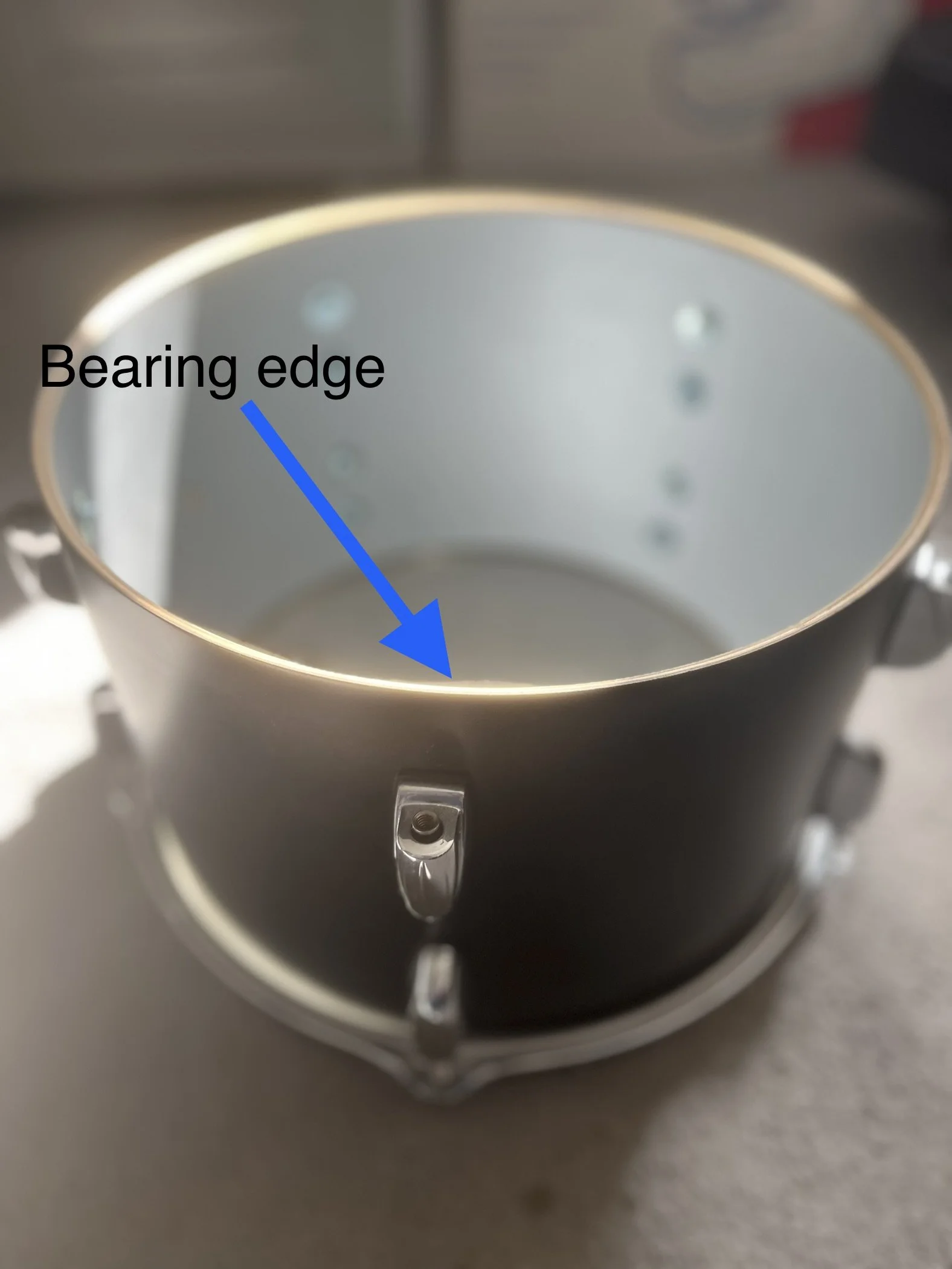Why Choosing The Right Bearing Edges Can Define Your Drum Sound
Starting to define your sound on the drums is an important artistic step. Of course, it’s not just about your technique and feel, the equipment you choose can also make a big difference: Understanding what influences a drum’s sound can help you to make decisions about your gear and achieve the sound you want.
Bearing edges are another of those important contributors to a drum’s sound, and making the right choice is important for developing the sound you want as a drummer.
But what are bearing edges, what difference do they make, and which should you look for in a drum?
What Are Bearing Edges On A Drum?
Drum bearing edges are the part of a drum shell that comes into contact with the drumhead.
They are typically made of wood or metal, and are cut to shape a precise angle where the drumhead meets the drum shell.
A drum with the batter head removed to show a 30-degree bearing edge
The angle of the bearing edge has a significant impact on the drum’s sound.
Drum manufacturers create drums with a particular type of bearing edge depending on the sound they want to achieve.
Generally speaking, sharper bearing edges produce a brighter and more focused sound, while rounded bearing edges produce a warmer and more resonant sound.
The more contact there is between the drum head and the shell, the more force that’s absorbed by the shell.
So, a large contact area means the shell controls the sound leading to less ‘attack’ - the sharp staccato characteristics of a drum’s tone.
What Are The Different Types Of Bearing Edge?
There are several different types of bearing edges that drum manufacturers use, each with its own unique sound characteristics. Some of the most common bearing edge types are described below.
Round-over bearing edges:
Rounded bearing edges have a large, rounded profile. They produces a warm and round sound, with a lot of sustain.
The round bearing edge was typical of early drum kits during the 20th century. Hence when we think of the warm vintage sounds some drummers look for a rounded bearing edge is partly contributing to that.
A full round bearing edge has a very large, rounded profile that extends all the way to the outer edge of the drum shell. It produces a warm and fat sound, with a lot of sustain.
Jazz drummers, and those looking for the warm vintage sound might look for round bearing edges, although these are rarer on modern drums.
The beautiful Gretsch Broadkaster kits are designed to hark back to the 1950s era and feature round bearing edges to achieve this sound.
Round-over bearing edge summary
Sound profile: warm, long sustain, vintage
Typical musical contexts: jazz, vintage rock n roll
Featuring kits: Gretsch Broadkaster, Tama Star Maple
Interested in the vintage drum sound? Check out Gretsch drums on Gear4music.
2. 30-Degree bearing edge
30 degree bearing edges sit between the sharper types such as 45-degree, and the round-over bearing edge.
The angle is soft, hence the sound it generates is balanced: somewhere between the brightness of the sharper angles, and the warmth of round-over bearing edges, achieving both defined stick response and warm sustained tones.
Because of the balance 30-degree bearing edges produce they are versatile: fitting in with styles from jazz to pop and rock.
Ludwig’s Legacy Maple series, described as a ‘modern twist on a vintage shell’ uses a 30-degree bearing edge, as well as a rounded outer, to create warm vintage tones with some definition added by the 30-degree angle inside.
Gretsch’s Catalina Club and Brooklyn series also feature 30-degree bearing edges.
30-degree bearing edge summary:
Sound profile: warm and balanced, long sustain, some stick definition and attack, vintage with modern hints
Typical musical contexts: versatile with vintage leanings - jazz, rock, pop
Featuring kits: Gretsch Catalina Club, Gretsch Brooklyn, Ludwig Legacy Maple
3. 45-degree degree bearing edge
45-degree bearing edges are the most popular for modern drum kits.
The sharp angle of 45 degrees produces a bright and focused sound, with a lot of attack, making it punchy to cut through in genres such as pop and rock.
Some drums feature two sharp 45 degree angles (imagine an arrow shape) to produce an even brighter and more focused sound than a single 45-degree edge that makes it useful for funky genres.
Pearl’s Masters series, Yamaha’s Absolute and The British Drum Company’s Legend series feature 45-degree bearing edges to achieve cut through and stick definition as well as sustain.
45-degree bearing edge summary:
Sound profile: Bright and focused, stick definition and attack, cuts through; typical of modern drums. Double 45-degree bearing edges are even brighter.
Typical musical contexts: versatile and modern - rock, RnB and pop, funk
Featuring kits: Pearl Masters, Yamaha Absolute, British Drum Co Legend
4. 60-degree degree bearing edge:
60-degree bearing edges have minimal contact with the drum head.
This means the attack and stick definition is a key characteristic, while the sustain and resonance is minimal. This sound profile is punchy, sharp and powerful, suitable for styles that need very sharp hits that cut through.
60-degree bearing edges are rarer than other types. Yamaha’s Masters Maple/Gum uses them however.
Which bearing edge should you use?
Drum manufacturers often use a combination of these types, or adjust them to make their own unique sound profiles.
The type of bearing edge that suits your style will depend on the style of music you’re playing, the type of drum, and your own personal preference for the sound you want to achieve: do you want a warm, resonant vintage sound, or a snappy and focused modern pop sound?
Experiment with drums that have different bearing edge types and angles when you’re in a drum shop (when you play a kit make a note of characteristics like the bearing edge) to find the perfect sound for your playing style.








